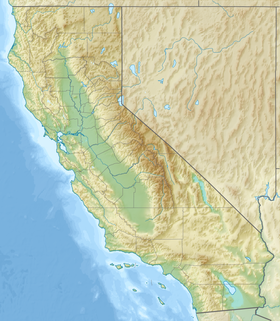San Gorgonio Pass
| San Gorgonio Pass | |
|---|---|
| Banning Pass | |
NGVD 29[1] | |
| Traversed by | |
| Location | Riverside County, California, United States |
| Range | San Bernardino Mountains / San Jacinto Mountains |
| Coordinates | 33°55′12.1″N 116°58′14.1″W / 33.920028°N 116.970583°W[1] |
| Topo map | Beaumont |
The San Gorgonio Pass, or Banning Pass, is a 2,600 ft (790 m) elevation
It serves as a major transportation corridor between the
The pass is one of the deepest mountain passes in the
Geology
The pass is the major geologic divide between the igneous batholithic
Geography
Climate
The San Gorgonio Pass area tends to get snow at least once or twice during the winter months, although it rarely sticks to hard surfaces, such as the freeway or city streets.
Topography
The San Gorgonio River runs through the pass, west to east, and joins the Whitewater River near the community of Whitewater at the northwest end of Coachella Valley.
Transportation
The
The summit of the pass is in
The Banning Municipal Airport, located in the pass, is a small public airport operated by the city of Banning.
Places in the San Gorgonio Pass
Populated places
- Banning
- Bonnie Bell
- Beaumont
- Cabazon
- Calimesa
- Cherry Valley
- Highland Springs
- Morongo Reservation
Places of interest
- AC Dysart Equestrian Center
- Bogart Regional Park
- Cabazon Dinosaurs
- Desert Hills Premium Outlets
- Edward-Dean Museum & Gardens
- Gilman Ranch
- Highland Springs Resort/Ranch & Inn
- Malki Museum
- Morongo Casino, Resort & Spa
- Museum of Pinball
- Pacific Crest Trail
- San Gorgonio Pass Wind Farm
Other notable facilities
References
- ^ a b c "San Gorgonio Pass". Geographic Names Information System. United States Geological Survey, United States Department of the Interior. Retrieved 2010-04-04.
- ^ https://watermark.silverchair.com/39.pdf?token=AQECAHi208BE49Ooan9kkhW_Ercy7Dm3ZL_9Cf3qfKAc485ysgAAAw4wggMKBgkqhkiG9w0BBwagggL7MIIC9wIBADCCAvAGCSqGSIb3DQEHATAeBglghkgBZQMEAS4wEQQMm2imrcTU6ZsacxTeAgEQgIICwVJzxlUOr1RRkMHXqSWRxop4Uylp2I_7Si-fCu87fYq7ojV6CUpwfNN2rNEpSTrCfEmsRajrhONOyIxClfZ918ze1vgBDknKBFG70uA0UZgeav2hds22Kjpey4osojEhHwL-rVwmP4ZlGkI_Xj0R6G43aHqN3sS5PpZmSzPLb1zhyzd_1xfLhCNhIh323RwRbgGAxgP3dXLp9dzwrotlj28lzCI_OGJncLOLkEvOtxnfEZvc5S64NFIFz6sWYKvcyw9y79Ot6C23ecTShYZ8ijLwXcJBqsAs2VeOnFf72fnnGkPMcYyefbw7br3T8MMb3qblZdhlgSDBqWGR4yNL-LYXNzxp0yY3NjEzcxv9AsbEpnK6f_54JiYi2P6RlwT54_Lp9VoT7isdMAZz2biYqaGPuCJFQGjjlr9ttWgkVkgQqnZcnZ4BaHSTIIAcTV8wMgd8SaUp3v-kFt1GcBaMGnLLjrTWVylvs6JyGcGJDEh4xFF-CCIGv3On2xtA45UXUEdnmoAtqmlU1LE1odPktPw7Xr3AS5fCf2U3I-12iG2E8zipkyzYA7RW_5DSEU9Cnf_EFtVKlkVD4Lj-hucxV-7_wQ0mKBSR9uBRd5r0-w-5KTVOhw_53baZKWuHvVcHiGdvhGwjMJySA1eOdz0fBWITFP_AsqCAfmerPiY4q7EPCdHac5NDSjImCiZilLYSTwITJCyntfsQp_AichDpFLCownJyK6tDN7o36xSD8k6MsQVcOSWVSug9iLGnwivT0qrkHdUzizeSlKtJh7a8VNJ4NLlBRFXC69-w7TpPY5SHobaH0JVBwwpQ1molygXutzoLGeBkQL85eWS_sUNiOZDC9tU2WnTaDnkJgVyovl9ltWL4SDGMuc4DKCYsEg5m1LYPs6CzuNbojWtx0LXzsE7E08TMeTKxV_3NuCHFiPm6GQ
- ^ Lech, p. 249.
- ^ Banning, CA, 7.5 Minute Topographic Quadrangle, USGS, 1953 (1988 rev.)
- .
Bibliography
- Gunther, Jane Davies. Riverside County, California, Place Names; Their Origins and Their Stories, Riverside, CA, 1984. LOC catalog number: 84–72920.
- Lech, Steve. Along the Old Roads: A History of the Portion of Southern California that became Riverside County 1772-1893, Riverside, CA, 2004.

